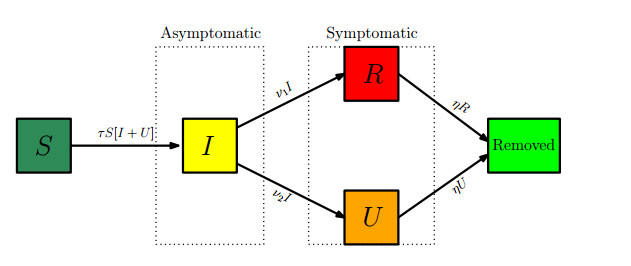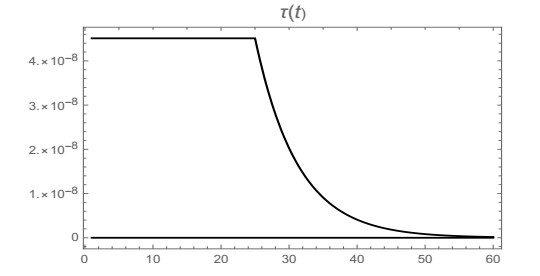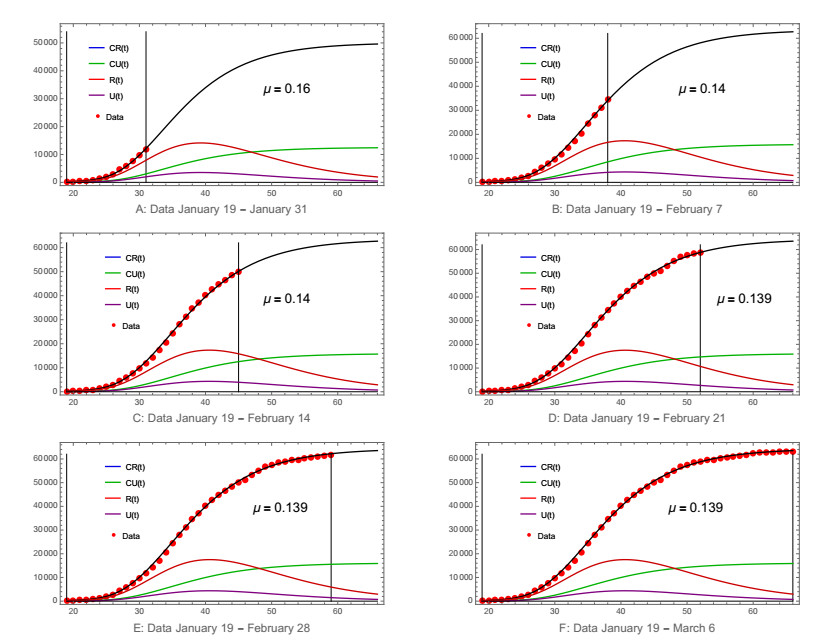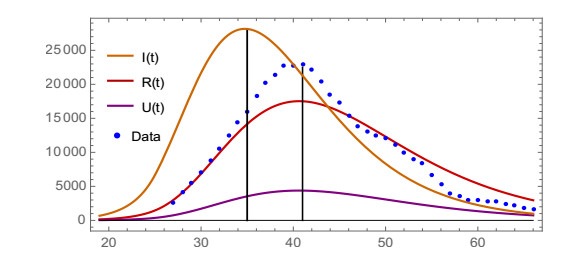| 1.
|
Richard A. J. Post, Marta Regis, Zhuozhao Zhan, Edwin R. van den Heuvel,
How did governmental interventions affect the spread of COVID-19 in European countries?,
2021,
21,
1471-2458,
10.1186/s12889-021-10257-2
|
|
| 2.
|
Quentin Griette, Pierre Magal,
Clarifying predictions for COVID-19 from testing data: The example of New York State,
2021,
6,
24680427,
273,
10.1016/j.idm.2020.12.011
|
|
| 3.
|
Raphaël Forien, Guodong Pang, Étienne Pardoux,
Estimating the state of the COVID-19 epidemic in France using a model with memory,
2021,
8,
2054-5703,
10.1098/rsos.202327
|
|
| 4.
|
W. E. FITZGIBBON, J. J. MORGAN, G. F. WEBB, Y. WU,
ANALYSIS OF A REACTION–DIFFUSION EPIDEMIC MODEL WITH ASYMPTOMATIC TRANSMISSION,
2020,
28,
0218-3390,
561,
10.1142/S0218339020500126
|
|
| 5.
|
Renato M. Cotta, Carolina P. Naveira-Cotta, Pierre Magal,
Mathematical Parameters of the COVID-19 Epidemic in Brazil and Evaluation of the Impact of Different Public Health Measures,
2020,
9,
2079-7737,
220,
10.3390/biology9080220
|
|
| 6.
|
Subhas Khajanchi, Kankan Sarkar,
Forecasting the daily and cumulative number of cases for the COVID-19 pandemic in India,
2020,
30,
1054-1500,
071101,
10.1063/5.0016240
|
|
| 7.
|
Jean Dolbeault, Gabriel Turinici, E. Augeraud, M. Banerjee, J.-S. Dhersin, A. d'Onofrio, T. Lipniacki, S. Petrovskii, Chi Tran, A. Veber-Delattre, E. Vergu, V. Volpert,
Heterogeneous social interactions and the COVID-19 lockdown outcome in a multi-group SEIR model,
2020,
15,
0973-5348,
36,
10.1051/mmnp/2020025
|
|
| 8.
|
Lionel Roques, Etienne K Klein, Julien Papaïx, Antoine Sar, Samuel Soubeyrand,
Using Early Data to Estimate the Actual Infection Fatality Ratio from COVID-19 in France,
2020,
9,
2079-7737,
97,
10.3390/biology9050097
|
|
| 9.
|
J. Demongeot, Q. Griette, P. Magal,
SI epidemic model applied to COVID-19 data in mainland China,
2020,
7,
2054-5703,
201878,
10.1098/rsos.201878
|
|
| 10.
|
Tingzhe Sun, Yan Wang,
Modeling COVID-19 epidemic in Heilongjiang province, China,
2020,
138,
09600779,
109949,
10.1016/j.chaos.2020.109949
|
|
| 11.
|
Tô Tat Dat, Protin Frédéric, Nguyen T. T. Hang, Martel Jules, Nguyen Duc Thang, Charles Piffault, Rodríguez Willy, Figueroa Susely, Hông Vân Lê, Wilderich Tuschmann, Nguyen Tien Zung,
Epidemic Dynamics via Wavelet Theory and Machine Learning with Applications to Covid-19,
2020,
9,
2079-7737,
477,
10.3390/biology9120477
|
|
| 12.
|
Qiwei Li, Tejasv Bedi, Christoph U Lehmann, Guanghua Xiao, Yang Xie,
Evaluating short-term forecasting of COVID-19 cases among different epidemiological models under a Bayesian framework,
2021,
10,
2047-217X,
10.1093/gigascience/giab009
|
|
| 13.
|
Seda İğret Araz,
Analysis of a Covid-19 model: Optimal control, stability and simulations,
2021,
60,
11100168,
647,
10.1016/j.aej.2020.09.058
|
|
| 14.
|
Tingzhe Sun, Dan Weng,
Estimating the effects of asymptomatic and imported patients on COVID‐19 epidemic using mathematical modeling,
2020,
92,
0146-6615,
1995,
10.1002/jmv.25939
|
|
| 15.
|
Quentin Griette, Pierre Magal, Ousmane Seydi,
Unreported Cases for Age Dependent COVID-19 Outbreak in Japan,
2020,
9,
2079-7737,
132,
10.3390/biology9060132
|
|
| 16.
|
Guo-Rong Xing, Ming-Tao Li, Li Li, Gui-Quan Sun,
The Impact of Population Migration on the Spread of COVID-19: A Case Study of Guangdong Province and Hunan Province in China,
2020,
8,
2296-424X,
10.3389/fphy.2020.587483
|
|
| 17.
|
Zhong-Kai Guo, Hong Xiang, Hai-Feng Huo,
Analysis of an age-structured tuberculosis model with treatment and relapse,
2021,
82,
0303-6812,
10.1007/s00285-021-01595-1
|
|
| 18.
|
Haitao Song, Zhongwei Jia, Zhen Jin, Shengqiang Liu,
Estimation of COVID-19 outbreak size in Harbin, China,
2021,
0924-090X,
10.1007/s11071-021-06406-2
|
|
| 19.
|
Christophe Besse, Grégory Faye,
Dynamics of epidemic spreading on connected graphs,
2021,
82,
0303-6812,
10.1007/s00285-021-01602-5
|
|
| 20.
|
Francesca Tang, Yang Feng, Hamza Chiheb, Jianqing Fan,
The Interplay of Demographic Variables and Social Distancing Scores in Deep Prediction of U.S. COVID-19 Cases,
2021,
0162-1459,
1,
10.1080/01621459.2021.1901717
|
|
| 21.
|
Cécile Aubert, Emmanuelle Augeraud-Véron, Maria Vittoria Barbarossa,
The relative power of individual distancing efforts and public policies to curb the COVID-19 epidemics,
2021,
16,
1932-6203,
e0250764,
10.1371/journal.pone.0250764
|
|
| 22.
|
Aakansha Gupta, Rahul Katarya,
Possibility of the COVID-19 third wave in India: mapping from second wave to third wave,
2023,
97,
0973-1458,
389,
10.1007/s12648-022-02425-w
|
|
| 23.
|
R. Prem Kumar, Sanjoy Basu, Dipankar Ghosh, Prasun Kumar Santra, G. S. Mahapatra,
Dynamical analysis of novel
COVID
‐19 epidemic model with non‐monotonic incidence function
,
2022,
22,
1472-3891,
10.1002/pa.2754
|
|
| 24.
|
S.Y. Tchoumi, M.L. Diagne, H. Rwezaura, J.M. Tchuenche,
Malaria and COVID-19 co-dynamics: A mathematical model and optimal control,
2021,
99,
0307904X,
294,
10.1016/j.apm.2021.06.016
|
|
| 25.
|
Victor M. Chan, Esteban A. Hernandez-Vargas, Edgar N. Sanchez,
2021,
Neural inverse optimal control applied to design therapeutic options for patients with COVID-19,
978-1-6654-3900-8,
1,
10.1109/IJCNN52387.2021.9534240
|
|
| 26.
|
K. D. Olumoyin, A. Q. M. Khaliq, K. M. Furati,
Data-Driven Deep-Learning Algorithm for Asymptomatic COVID-19 Model with Varying Mitigation Measures and Transmission Rate,
2021,
2,
2673-3986,
471,
10.3390/epidemiologia2040033
|
|
| 27.
|
Fathalla A. Rihan, K. Udhayakumar, Nicola Sottocornola, M.-Naim Anwar, Abdul Q. M. Khaliq,
Stability and Bifurcation Analysis of the Caputo Fractional-Order Asymptomatic COVID-19 Model with Multiple Time-Delays,
2023,
33,
0218-1274,
10.1142/S0218127423500220
|
|
| 28.
|
Quentin Griette, Jacques Demongeot, Pierre Magal,
What Can We Learn from COVID-19 Data by Using Epidemic Models with Unidentified Infectious Cases?,
2021,
1556-5068,
10.2139/ssrn.3868852
|
|
| 29.
|
Kayode Oshinubi, Firas Ibrahim, Mustapha Rachdi, Jacques Demongeot,
Functional data analysis: Application to daily observation of COVID-19 prevalence in France,
2022,
7,
2473-6988,
5347,
10.3934/math.2022298
|
|
| 30.
|
M. L. Diagne, H. Rwezaura, S. Y. Tchoumi, J. M. Tchuenche, Jan Rychtar,
A Mathematical Model of COVID-19 with Vaccination and Treatment,
2021,
2021,
1748-6718,
1,
10.1155/2021/1250129
|
|
| 31.
|
Pradeep K. Jha, Suvadip Ghorai, Rakhi Jha, Rajul Datt, Gowrishankar Sulapu, Surya Prakash Singh,
Forecasting the impact of epidemic outbreaks on the supply chain: modelling asymptomatic cases of the COVID-19 pandemic,
2021,
0020-7543,
1,
10.1080/00207543.2021.1982152
|
|
| 32.
|
József Z. Farkas, Roxane Chatzopoulos,
Assessing the Impact of (Self)-Quarantine through a Basic Model of Infectious Disease Dynamics,
2021,
13,
2036-7449,
978,
10.3390/idr13040090
|
|
| 33.
|
E. Iván Guerrero-Flores, J. Héctor Morales-Bárcenas, Gabriel Núñez-Antonio,
2022,
Chapter 7,
978-3-031-12777-9,
115,
10.1007/978-3-031-12778-6_7
|
|
| 34.
|
Jayrold P. Arcede, Rachel C. Basañez, Youcef Mammeri,
2022,
Chapter 7,
978-981-16-7856-1,
75,
10.1007/978-981-16-7857-8_7
|
|
| 35.
|
Haitao Song, Fang Liu, Feng Li, Xiaochun Cao, Hao Wang, Zhongwei Jia, Huaiping Zhu, Michael Y. Li, Wei Lin, Hong Yang, Jianghong Hu, Zhen Jin,
Modeling the second outbreak of COVID-19 with isolation and contact tracing,
2022,
27,
1531-3492,
5757,
10.3934/dcdsb.2021294
|
|
| 36.
|
Quentin Griette, Jacques Demongeot, Pierre Magal,
What can we learn from COVID-19 data by using epidemic models with unidentified infectious cases?,
2021,
19,
1551-0018,
537,
10.3934/mbe.2022025
|
|
| 37.
|
Jie Long, A. Q. M. Khaliq, K. M. Furati,
Identification and prediction of time-varying parameters of COVID-19 model: a data-driven deep learning approach,
2021,
98,
0020-7160,
1617,
10.1080/00207160.2021.1929942
|
|
| 38.
|
Omaji Samuel, Akogwu Blessing Omojo, Abdulkarim Musa Onuja, Yunisa Sunday, Prayag Tiwari, Deepak Gupta, Ghulam Hafeez, Adamu Sani Yahaya, Oluwaseun Jumoke Fatoba, Shahab Shamshirband,
IoMT: A COVID-19 Healthcare System Driven by Federated Learning and Blockchain,
2023,
27,
2168-2194,
823,
10.1109/JBHI.2022.3143576
|
|
| 39.
|
Nikolaos Stasinos, Anestis Kousis, Vangelis Sarlis, Aristeidis Mystakidis, Dimitris Rousidis, Paraskevas Koukaras, Ioannis Kotsiopoulos, Christos Tjortjis,
A Tri-Model Prediction Approach for COVID-19 ICU Bed Occupancy: A Case Study,
2023,
16,
1999-4893,
140,
10.3390/a16030140
|
|
| 40.
|
Sanjoy Basu, R. Prem Kumar, P.K. Santra, G.S. Mahapatra, A.A. Elsadany,
Preventive control strategy on second wave of Covid-19 pandemic model incorporating lock-down effect,
2022,
61,
11100168,
7265,
10.1016/j.aej.2021.12.066
|
|
| 41.
|
Yan Wang, Feng Qing, Haozhan Li, Xuteng Wang,
Timely and effective media coverage's role in the spread of Corona Virus Disease 2019,
2022,
0170-4214,
10.1002/mma.8732
|
|
| 42.
|
J. Waku, K. Oshinubi, J. Demongeot,
Maximal reproduction number estimation and identification of transmission rate from the first inflection point of new infectious cases waves: COVID-19 outbreak example,
2022,
198,
03784754,
47,
10.1016/j.matcom.2022.02.023
|
|
| 43.
|
Salihu S. Musa, Isa A. Baba, Abdullahi Yusuf, Tukur A. Sulaiman, Aliyu I. Aliyu, Shi Zhao, Daihai He,
Transmission dynamics of SARS-CoV-2: A modeling analysis with high-and-moderate risk populations,
2021,
26,
22113797,
104290,
10.1016/j.rinp.2021.104290
|
|
| 44.
|
Lan Meng, Wei Zhu,
Analysis of SEIR epidemic patch model with nonlinear incidence rate, vaccination and quarantine strategies,
2022,
200,
03784754,
489,
10.1016/j.matcom.2022.04.027
|
|
| 45.
|
Mostafa Bachar, Mohamed A. Khamsi, Messaoud Bounkhel,
A mathematical model for the spread of COVID-19 and control mechanisms in Saudi Arabia,
2021,
2021,
1687-1847,
10.1186/s13662-021-03410-z
|
|
| 46.
|
Paulo Roberto de Lima Gianfelice, Ricardo Sovek Oyarzabal, Americo Cunha, Jose Mario Vicensi Grzybowski, Fernando da Conceição Batista, Elbert E. N. Macau,
The starting dates of COVID-19 multiple waves,
2022,
32,
1054-1500,
031101,
10.1063/5.0079904
|
|
| 47.
|
Tchavdar T. Marinov, Rossitza S. Marinova,
Inverse problem for adaptive SIR model: Application to COVID-19 in Latin America,
2022,
7,
24680427,
134,
10.1016/j.idm.2021.12.001
|
|
| 48.
|
Mustapha Hankar, Marouane Birjali, Abderrahim Beni-Hssane,
2022,
Chapter 59,
978-981-16-3636-3,
845,
10.1007/978-981-16-3637-0_59
|
|
| 49.
|
Abdon Atangana, Seda İgret Araz,
2022,
Chapter 8,
978-981-19-0728-9,
237,
10.1007/978-981-19-0729-6_8
|
|
| 50.
|
Ousmane Koutou, Abou Bakari Diabaté, Boureima Sangaré,
Mathematical analysis of the impact of the media coverage in mitigating the outbreak of COVID-19,
2023,
205,
03784754,
600,
10.1016/j.matcom.2022.10.017
|
|
| 51.
|
Quentin Griette, Zhihua Liu, Pierre Magal, Robin N. Thompson,
2022,
Chapter 8,
978-3-030-85052-4,
173,
10.1007/978-3-030-85053-1_8
|
|
| 52.
|
Isa A. Baba, Usa W. Humphries, Fathalla A. Rihan, J. E. N. Valdés,
Fractional–Order Modeling and Control of COVID-19 with Shedding Effect,
2023,
12,
2075-1680,
321,
10.3390/axioms12040321
|
|
| 53.
|
Fathalla A. Rihan, Udhayakumar Kandasamy, Hebatallah J. Alsakaji, Nicola Sottocornola,
Dynamics of a Fractional-Order Delayed Model of COVID-19 with Vaccination Efficacy,
2023,
11,
2076-393X,
758,
10.3390/vaccines11040758
|
|
| 54.
|
Zhong-Kai Guo, Hai-Feng Huo, Hong Xiang,
TRANSMISSION DYNAMICS AND OPTIMAL CONTROL OF AN AGE-STRUCTURED TUBERCULOSIS MODEL,
2024,
14,
2156-907X,
1434,
10.11948/20230248
|
|
| 55.
|
Aakansha Gupta, Rahul Katarya,
A deep-SIQRV epidemic model for COVID-19 to access the impact of prevention and control measures,
2023,
107,
14769271,
107941,
10.1016/j.compbiolchem.2023.107941
|
|
| 56.
|
Cécile Aubert, Hai-Anh Dang, Manh-Hung Nguyen,
The Unequal Impact of Covid-19: Health, Wealth and Behaviors by Income Groups,
2022,
Volume XXXVII,
0769-0479,
43,
10.3917/rfe.222.0043
|
|
| 57.
|
Hippolyte d’Albis, Emmanuelle Augeraud-Véron, Dramane Coulibaly, Rodolphe Desbordes,
Covid-19 and mobility: determinant or consequence?,
2024,
77,
0938-2259,
261,
10.1007/s00199-023-01510-3
|
|
| 58.
|
Zhong-Kai Guo, Hai-Feng Huo, Hong Xiang, Qiu-Yan Ren,
Global dynamics of a tuberculosis model with age-dependent latency and time delays in treatment,
2023,
87,
0303-6812,
10.1007/s00285-023-01999-1
|
|
| 59.
|
Jacques Demongeot, Pierre Magal,
Data-driven mathematical modeling approaches for COVID-19: A survey,
2024,
50,
15710645,
166,
10.1016/j.plrev.2024.08.004
|
|
| 60.
|
Helio Schechtman, Max O. Souza,
2024,
Chapter 60,
978-3-031-49400-0,
580,
10.1007/978-3-031-49401-7_60
|
|
| 61.
|
Padma Bhushan Borah, Hemanta Kumar Sarmah,
2024,
Chapter 41,
978-3-031-52964-1,
517,
10.1007/978-3-031-52965-8_41
|
|
| 62.
|
Mahnoosh Tajmirriahi, Zahra Amini, Rahele Kafieh, Hossein Rabbani, Ali Mirzazadeh, Shaghayegh Haghjooy Javanmard,
Statistical Inference of COVID-19 Outbreak,
2022,
12,
2228-7477,
95,
10.4103/jmss.jmss_134_21
|
|
| 63.
|
R. Prem Kumar, Sanjoy Basu, P. K. Santra, Abdelalim A. Elsadany, Amr Elsonbaty, G. S. Mahapatra, A. Al-khedhairi,
Global stability and sensitivity analysis of parameters of Omicron variant epidemic in diverse susceptible classes incorporating vaccination stages,
2023,
1432-7643,
10.1007/s00500-023-09170-0
|
|
| 64.
|
Bande Ganesh, V. Ravinder Naik, Banothu Ramji, Veerender Aerranagula, B. Sankara Babu, Sandeep Sharma, S. Swadesh Kumar,
Predicting the Spread of the Corona Virus Disease Requires Analyzing Data from Cases across Multiple States in India,
2023,
430,
2267-1242,
01153,
10.1051/e3sconf/202343001153
|
|
| 65.
|
Raúl Guinovart-Díaz, Wilfredo Morales-Lezca, Isidro Abelló-Ugalde, Julián Bravo-Castillero, Kuppalapalle Vajravelu, David Guinovart,
Multipopulation mathematical modeling of vaccination campaign of COVID-19 in Cuba,
2025,
0228-6203,
1,
10.1080/02286203.2025.2457762
|
|









 DownLoad:
DownLoad:












